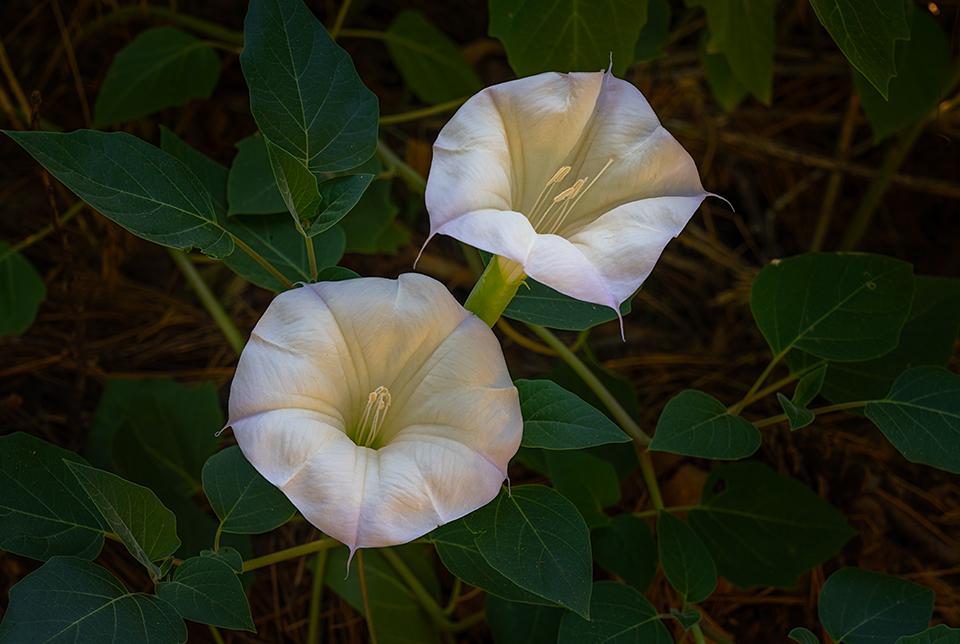
Datura blooms, Yosemite National Park / Rebecca Latson
Yosemite National Park encompasses almost 1,200 square miles. Not only can a visitor see and do plenty in this park, but they can learn plenty, as well. I certainly learned quite a bit during my late August visit and I want to share what I learned with you in the form of this quiz and trivia piece. Test your knowledge with these questions before checking the answers at the bottom of the quiz.
1. While wandering one of the trails within the Yosemite Valley, I came across a small patch of lovely creamy-white trumpet-shaped flowers. They go by the name Datura but are also known as:
a) Ayahuasca
b) Jimsonweed
c) Betel
d) Peyote

Olmsted Point landscape, Yosemite National Park / Rebecca Latson
2. If you visit Yosemite in the summer, you’ll be able to drive Tioga Road, with all the stunning High Sierra landscape on either side. Along the route, Olmsted Point is a must-see stop, not only for a different view of Half Dome, but also to view the high country, including large boulders strewn haphazardly all over the landscape, deposited by the glaciers that once covered the area. These boulders dropped off by glaciers are called:
a) Till
b) Tarns
c) Moraine
d) Erratics
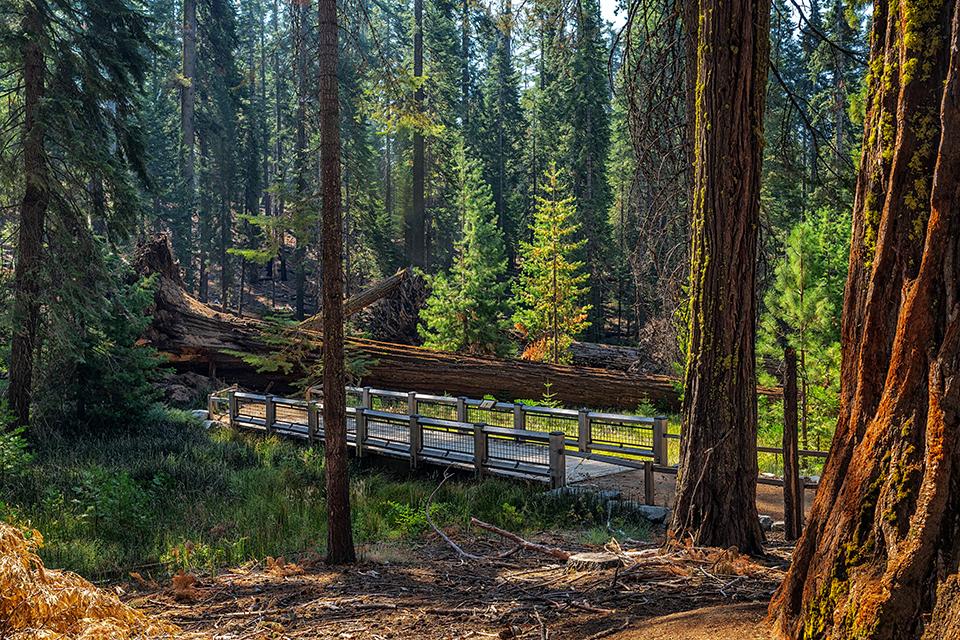
Downed Sequoias at Mariposa Grove, Yosemite National Park / Rebecca Latson
3. If you hike the 1.9-mile (one-way) trail from the Mariposa Grove Welcome Plaza to the Mariposa Grove of giant Sequoia trees, you’ll notice a number of downed Sequoias and a portion of the trail fenced off and closed to visitors. This is because of an event that occurred back in January 2021 known as the:
a) Santa Ana wind
b) Chinook wind
c) Mono wind
d) Doldrum wind
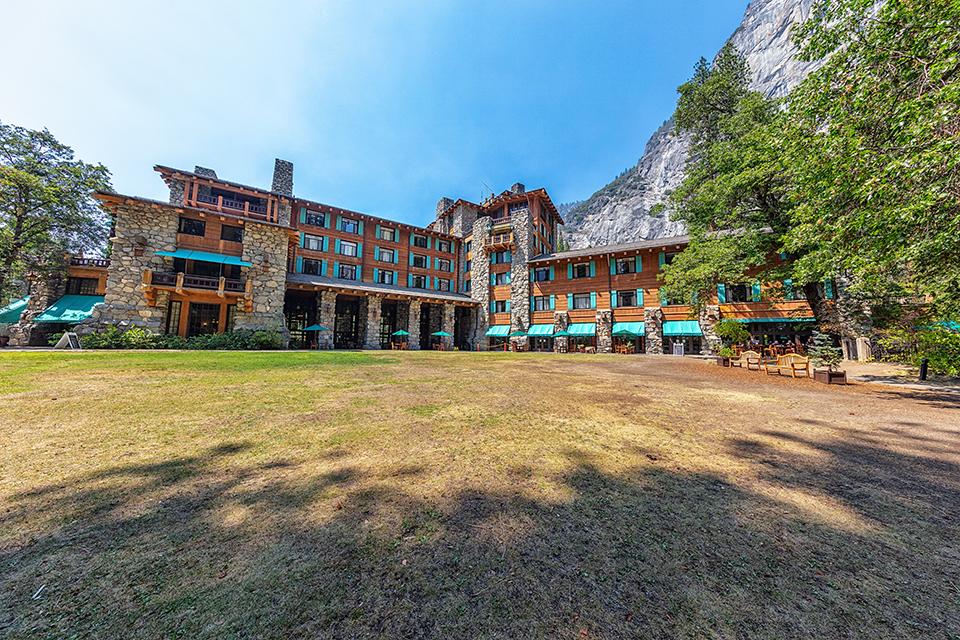
Ahwahnee Hotel, Yosemite National Park / Rebecca Latson
4. True or False: Steve Jobs was married in a Buddhist ceremony at Yosemite’s Ahwahnee Hotel.
a) True
b) False
5. True or False: Yosemite National Park put in a bid to host the 1928 Winter Olympics.
a) True
b) False
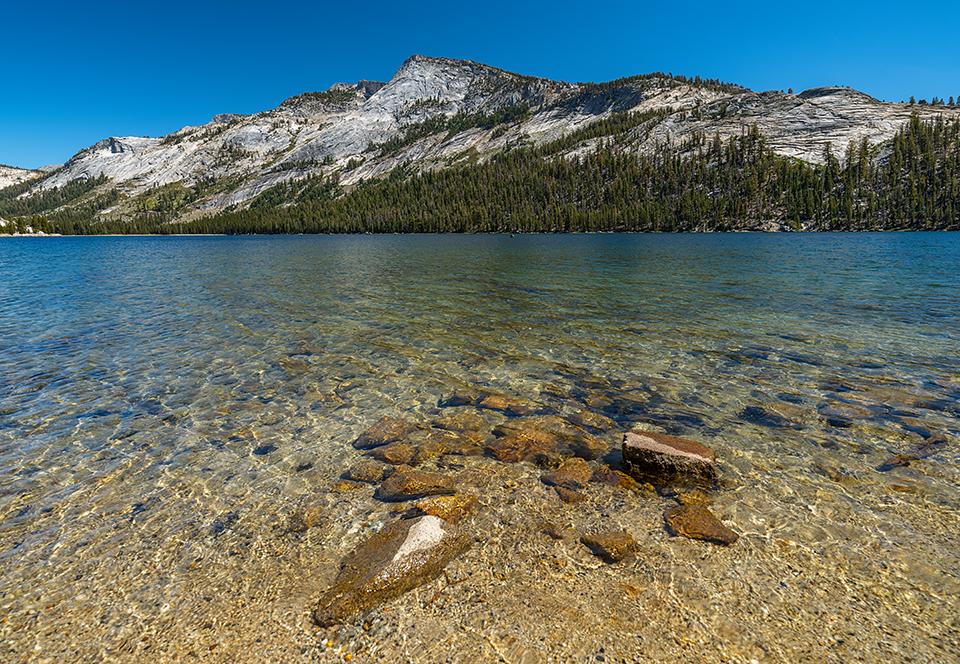
The crystal-clear water of Tenaya Lake, Yosemite National Park / Rebecca Latson
6. True or False: Tenaya Lake, popular with swimmers, kayakers, and paddleboarders, is the smallest lake in Yosemite National Park.
a) True
b) False
7. “Yosemite National Park supports more than ______ species of vertebrates…”
a) 400
b) 800
c) 200
d) 300

A jointed and fractured rock face along Tioga Road, Yosemite National Park / Rebecca Latson
8. As you drive along Tioga Road, take note of the rounded granite formations on either side of the road. Look closer and you’ll see parallel cracks along the rock face, forming thick and thin slabs of granite, which will eventually slough off the rock face. This erosional process is called:
a) Exfoliation
b) Onion peeling
c) Slickensiding
d) Slicing

A boardwalk through a Yosemite Valley meadow, Yosemite National Park / Rebecca Latson
9. Yosemite Valley has several beautiful examples of meadows, such as Cook’s Meadow, between Yosemite Village and Yosemite Valley Lodge. “Meadows are sponges, absorbing water as snowpack melts and holding that water like an underground water tower. At just 3% of Yosemite National Park's area, meadows contain a much larger proportion of Yosemite's species. Recently, in 2003, an entirely new species of orchid, called the Yosemite bog-orchid, was discovered in Yosemite's meadows. It's possible, in fact, that one-third of all of the plant species found in Yosemite occur in meadows.” So, what defines a “meadow?”
a) Hydrology
b) Vegetation
c) Soil characteristics
d) a & b
e) b & c
f) a & c
g) All of the above

A brightly-colored lichen, Yosemite National Park / Rebecca Latson
10. As you hike the trails of Yosemite National Park, you’ll notice a bright chartreuse (yellow-green) lichen growing on the side of many trees. This lichen is called:
a) Wolf lichen
b) Candelaira
c) Beard lichen
d) Dog lichen
Trivia

An 1899 photo of Buffalo Soldiers in the 24th Infantry, Yosemite National Park / National Park Service
“Buffalo Soldiers, like their white counterparts in U.S. Army regiments, were among the first park rangers, in general, and backcountry rangers, in particular, patrolling parts of the West. African-American army regiments, formed just after the Civil War, had been dispatched westward where these black soldiers fought in the Indian Wars and were eventually given the name Buffalo Soldiers by the Cheyenne and other Plains Indians who saw a resemblance between their dark, curly hair and the matted cushion between the horns of the buffalo ... Approximately 500 Buffalo Soldiers served in Yosemite National Park and nearby Sequoia National Park with duties from evicting poachers and timber thieves to extinguishing forest fires. Their noteworthy accomplishments were made despite the added burden of racism." To learn more about these protectors of the park, click here.

A telephoto view of Half Dome from Olmsted Point, Yosemite National Park / Rebecca Latson

I spy with my little eye: tiny little climbers scaling Half Dome, Yosemite National Park / Rebecca Latson
A stop at Olmsted Point, along the Tioga Road, provides a view of the northern side of Half Dome. If you have a telephoto lens or binoculars, you might be able to zoom in close enough to espy tiny, ant-like figures climbing a cable ladder up to Half Dome’s top. “Rising nearly 5,000 feet above Yosemite Valley and 8,800 feet above sea level, Half Dome is a Yosemite icon and a great challenge to many hikers. Despite an 1865 report declaring that it was ‘perfectly inaccessible, being probably the only one of the prominent points about the Yosemite which never has been, and never will be, trodden by human foot,’ George Anderson reached the summit in 1875, in the process laying the predecessor to today's cable route.” It’s a round trip 16-mile hike, with “two metal cables [to] allow hikers to climb the last 400 feet to the summit without rock climbing equipment.” To learn more about this hike and securing a permit, click here.
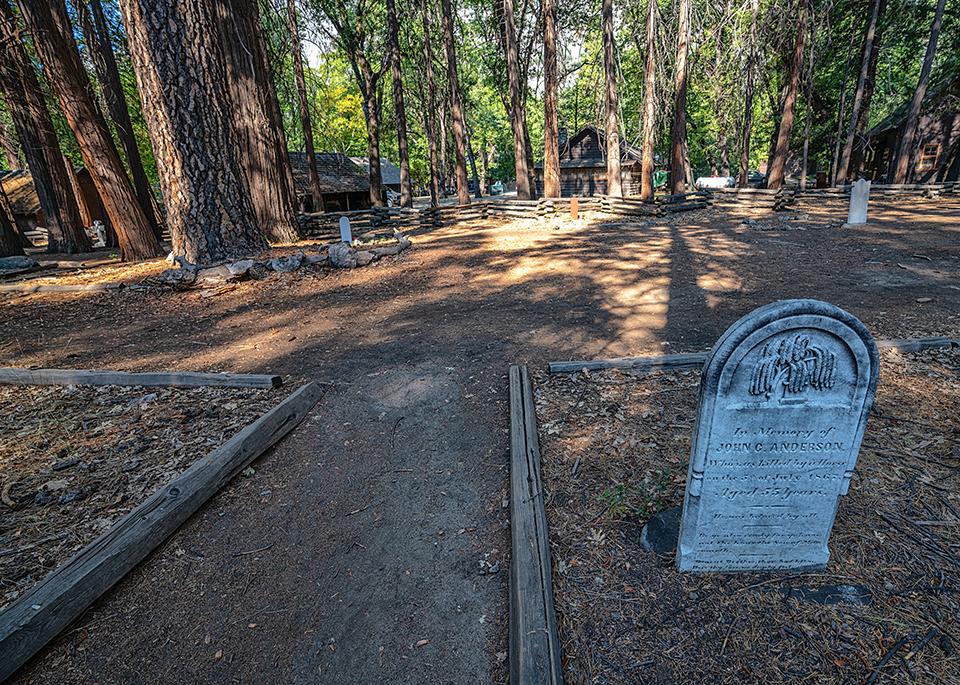
Yosemite Cemetery, Yosemite National Park / Rebecca Latson
If you are roaming Yosemite Village and looking for little bit of peace and quiet, why not visit Yosemite Cemetery. As I wandered around the cemetery, I was struck by how young many were at the time of their death. Yosemite is beautiful, but the life was not easy. There were no paved roads or paved trails or grocery stores or electricity and other utilities that we take for granted. ‘The Yosemite Cemetery is full of stories, told and untold. This quiet retreat on the west end of Yosemite Village is the final resting place of many of Yosemite's early residents. Some of those laid to rest here are well-known figures in the history of the park. Some spent their entire lives in Yosemite and are now almost forgotten. Others were visitors about whom very little was known, even at their time of their deaths. There are people who died here while on vacation, early settlers and homesteaders, old timers and infants, hotel proprietors and common laborers, each with a story. Many of these stories are entwined like strands in a rope that spans a century or more. Some stories are short and alone. Some, like those of American Indians buried here are so hidden we may never know them.” To read more about this cemetery and how a tall stand of Sequoia trees came to surround one grave, click here.
Quiz Answers
1b
Datura has many names, including jimsonweed, moonflower, and thornapple. “The datura unfurls its flowers in the early evening, remaining open to nighttime pollinators until they close again the following morning. Visiting insects include the sphinx moth, which uses its long tongue to reach nectar found at the base of the long flowers. The white color of the flowers reflect moonlight, making it easier for moths to find the flowers from a distance, but primarily it is their fragment smell that lures in pollinators. A variety of wasps and beetles also pollinate these flowers of the night.” It was morning when I photographed these flowers, but they were located in a shaded area, which may be why they were still unfurled and open to the bees buzzing around them.
2d
“The erratics at Olmsted Point are mainly solitary boulders…brought here by glaciers. In some cases, the boulders rest on bedrock surfaces that are polished and striated” from the gouging and sliding of sediment-laden glacier ice over the landscape. You might also notice that some large erratics look different (darker, lighter) than the surrounding rock, meaning they were transported away from their original location.
3c
“‘Mono winds’ dive out of the High Sierra from the east, typically between October and April but especially during December and January, and funnel through the foothills with speeds that can approach 100 mph.” A January 2021 article by the Traveler reports on this occurrence and the damaged caused by this wind event within the park.
4a True
On March 18, 1991. Apple co-founder Steve Jobs married Stanford MBA Laurene Powell on the back lawn of the Ahwahnee Hotel, and celebrated after the ceremony with a vegen wedding cake in the shape of Half Dome.
5b False
Actually, it was a bid for the 1932 Winter Olympics (gotcha!). After a visit to the 1928 Olympics, then-park concessionaire Don Tresidder thought it would be a great idea for Yosemite to host the 1932 games. Ultimately, Lake Placid won out.
6b False
According to the National Park Service, Tenaya Lake, “named after Chief Tenaya, who was the last chief of the Yosemite Indians” is the largest lake in Yosemite National Park.
7a
“Yosemite National Park supports more than 400 species of vertebrates including fish, amphibians, reptiles, birds, and mammals. The high diversity of species is the result of diverse habitats in Yosemite that are largely intact. The park’s rich habitats range from thick foothill chaparral to conifer forests to expanses of alpine rock.” To learn more about Yosemite’s animals, click here.
8a
Granite is a rock that forms deep beneath the earth’s surface, under immense pressure. Upon erosion of the overlying rock, the granite – now exposed to the surface atmosphere – begins to expand and fracture, creating parallel joints. The lessening of overlying rock pressure allows slabs of rock to “peel” off the exposed granite and leave a more rounded surface to the rock formation. This process is known as exfoliation.
9g
“In the simplest terms, what defines a meadow? Hydrology, vegetation, and soil characteristics. Note that ‘meadow’ is not a technical term as much as a cultural term. Classification systems, set by state and federal regulation, often set detailed guidelines that differ as to what constitutes a meadow.” To learn more about the meadows of Yosemite National Park, click here.
10a
Lichens, such as the wolf lichen (Letharia vulpine), don’t have roots, stems, or leaves. You’ll see them growing on trees, but don’t worry, they don’t hurt the trees. Wolf lichen is “a squatter, taking advantage of the crags and crevasses of the bark to latch onto…Wolf lichen is cold tolerant, and researchers think it may even photosynthesize in the winter…Wolf lichen has served in flower arrangements, a dye, a poultice, and even a poison” So, while many lichens may be eaten by humans and wildlife, this is one lichen you should not taste. To learn more about lichens in the park, click here.
References
In addition to information found on the NPS.gov park website, I also used the following publications/links as reference:
James Kaiser, Yosemite: The Complete Guide, 2020, Destination Press
Allen F. Glazner and Greg M. Stock, Geology Underfoot In Yosemite National Park, 2010, Mountain Press Publishing Company
https://www.cultofmac.com/534281/steve-jobs-gets-married/
https://www.doi.gov/blog/9-things-you-didnt-know-about-yosemite-national-park
https://www.npca.org/articles/1278-the-u-s-national-park-that-bid-for-the-olympics
https://www.geo.fu-berlin.de/en/v/geolearning/mountain_building/weathering/weathering2/index.html



Comments
Thanks for another quiz and trivia, Rebecca. Here is some more trivia.
The reference to Tioga Road piqued my interest, so I visited https://www.nps.gov/yose/planyourvisit/seasonal.htm to find out when the road opened. That page listed opening and closing dates for Tioga, Glacier Point, and Mariposa Grove, and it allowed me to sort on any column. Since I was interested in Tioga Road, I sort on that column. Boy was I surprised. It sorted the dates alphabetically, so the first entry was Apr 29, followed (non-consecutively; this is just to show the order) by Jul 1, Jun 24, Jun 3, June 15 (someone spelled the whole word rather than using three letters), May 19, May 2, May 21, and ending with May 8. Sorry for the off-topic digression, but it was so bizarre. It could have been a quiz question: how does the NPS sort dates?